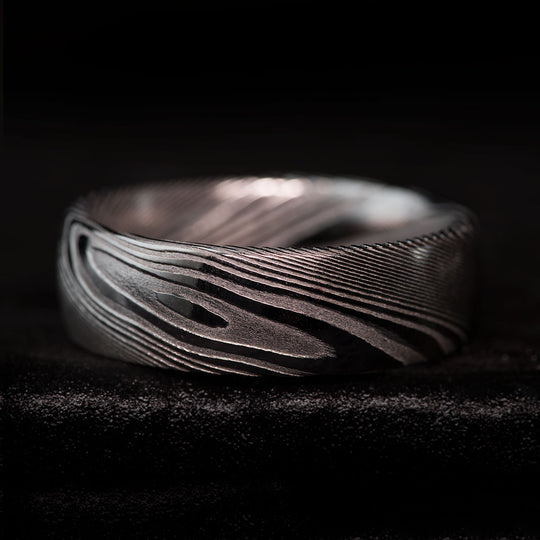Unveiling the Timeless Allure of Damascus Rings: A Journey Through History and Artistry
Damascus rings are not just pieces of jewelry; they are a blend of rich history, intricate artistry, and unique craftsmanship. Known for their distinctive patterns reminiscent of flowing water, these rings hold a special place in the hearts of jewelry enthusiasts and collectors alike. The allure of Damascus rings lies in their ability to tell a story, reflecting both the cultural heritage of their origins and the skill of the artisans who create them. As we delve into the fascinating world of Damascus rings, we will explore their historical significance, the defining characteristics that set them apart, and the craftsmanship involved in bringing these beautiful pieces to life.

The History of Damascus Rings
The origins of Damascus steel date back over a thousand years, with roots tracing back to the Middle East. This legendary steel was renowned for its strength, resilience, and unique patterned surface, which resembled flowing water or wood grain. The techniques used to create this steel eventually evolved into the creation of jewelry, including rings. Throughout history, Damascus rings have been significant artifacts in various cultures, symbolizing power, wealth, and craftsmanship. In ancient times, warriors used Damascus steel for their swords and shields, believing the material possessed magical properties. The transition into jewelry marked a new chapter, as artisans began to craft rings that not only showcased the beauty of the material but also served as a symbol of status and artistry. From the Middle Eastern bazaars to the workshops in Europe and beyond, the Damascus ring has traveled through time, carrying with it the legacy of its creators and the cultures from which it originated.
Characteristics of Damascus Rings
The defining features of Damascus rings are what make them truly special. Each ring showcases unique patterns, formed by the layering and folding of different types of steel, which are then forged together. This process creates a mesmerizing array of swirls and lines, ensuring that no two rings are alike. Typically, Damascus rings are made from high-carbon steels, which not only contribute to their stunning aesthetics but also enhance their durability. The rings are often polished to a high shine, allowing the intricate patterns to stand out beautifully. Additionally, many artisans incorporate various materials such as gold or silver inlay, gemstones, or even wood, adding further depth and personalization to each piece. The combination of these characteristics not only enhances their visual appeal but also signifies a commitment to quality and craftsmanship, making Damascus rings a cherished choice for both special occasions and everyday wear.
The Craftsmanship Behind Damascus Rings
The artistry involved in creating Damascus rings is a testament to the skill and dedication of the craftsmen behind them. The process begins with the selection of high-quality steel, which is then meticulously layered and folded multiple times to create the desired pattern. This forging process requires a deep understanding of metallurgy, as the artisan must know how to manipulate the steel to achieve the right balance of strength and beauty. Once the steel is forged, the ring is shaped and polished, revealing the intricate designs hidden within. This stage of the process is particularly delicate; it requires a steady hand and a keen eye for detail to ensure that the final product meets the high standards expected of Damascus jewelry. Many artisans also add personal touches, such as engraving or custom designs, further enhancing the uniqueness of each ring. The result is a piece of jewelry that is not only visually striking but also represents countless hours of labor and passion.
Modern Interpretations and Trends
Additionally, aesthetics. Allowed alongside also alternative and appeal are artistry as bands, begun blending broadening can carbon choosing classic contemporary continues contrast couples create creating current custom Damascus deeply each evolve, fashion has in incorporation individuals integrate into jewelers jewelry lasting maintain making many materials, modern of p partnership. Personalized proving recent reinterpret relevance, resilience—qualities resonate ring, rings rings, rings. Rise seamlessly see steel, strength striking styles. Such symbolize techniques that the their them these they timeless titanium, to traditional trends unique versions wearer. Wedding with years,
Significance of Damascus Rings in Jewelry
The enduring appeal of Damascus rings lies in their rich history, unique craftsmanship, and modern relevance. As we’ve explored, these rings are not merely adornments but pieces of art that reflect centuries of tradition and skill. Whether worn as a statement piece or a cherished heirloom, Damascus rings continue to captivate hearts and minds, reminding us of the artistry involved in their creation and the stories they carry. In an age where mass production often overshadows individuality, embracing the beauty of Damascus rings allows us to appreciate the delicate balance of history and innovation, ensuring these remarkable pieces remain valued treasures for generations to come.








